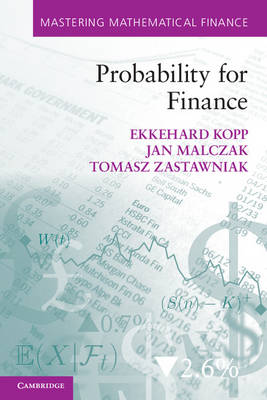Mastering Mathematical Finance
6 total works
Numerical Methods in Finance with C++
by Maciej J. Capinski and Tomasz Zastawniak
Published 26 July 2012
Driven by concrete computational problems in quantitative finance, this book provides aspiring quant developers with the numerical techniques and programming skills they need. The authors start from scratch, so the reader does not need any previous experience of C++. Beginning with straightforward option pricing on binomial trees, the book gradually progresses towards more advanced topics, including nonlinear solvers, Monte Carlo techniques for path-dependent derivative securities, finite difference methods for partial differential equations, and American option pricing by solving a linear complementarity problem. Further material, including solutions to all exercises and C++ code, is available online. The book is ideal preparation for work as an entry-level quant programmer and it gives readers the confidence to progress to more advanced skill sets involving C++ design patterns as applied in finance.
Modelling credit risk accurately is central to the practice of mathematical finance. The majority of available texts are aimed at an advanced level, and are more suitable for PhD students and researchers. This volume of the Mastering Mathematical Finance series addresses the need for a course intended for master's students, final-year undergraduates, and practitioners. The book focuses on the two mainstream modelling approaches to credit risk, namely structural models and reduced-form models, and on pricing selected credit risk derivatives. Balancing rigorous theory with examples, it takes readers through a natural development of mathematical ideas and financial intuition.
This volume in the Mastering Mathematical Finance series strikes just the right balance between mathematical rigour and practical application. Existing books on the challenging subject of stochastic interest rate models are often too advanced for Master's students or fail to include practical examples. Stochastic Interest Rates covers practical topics such as calibration, numerical implementation and model limitations in detail. The authors provide numerous exercises and carefully chosen examples to help students acquire the necessary skills to deal with interest rate modelling in a real-world setting. In addition, the book's webpage at www.cambridge.org/9781107002579 provides solutions to all of the exercises as well as the computer code (and associated spreadsheets) for all numerical work, which allows students to verify the results.
Probability for Finance
by Ekkehard Kopp, Jan Malczak, and Tomasz Zastawniak
Published 21 November 2013
Students and instructors alike will benefit from this rigorous, unfussy text, which keeps a clear focus on the basic probabilistic concepts required for an understanding of financial market models, including independence and conditioning. Assuming only some calculus and linear algebra, the text develops key results of measure and integration, which are applied to probability spaces and random variables, culminating in central limit theory. Consequently it provides essential prerequisites to graduate-level study of modern finance and, more generally, to the study of stochastic processes. Results are proved carefully and the key concepts are motivated by concrete examples drawn from financial market models. Students can test their understanding through the large number of exercises and worked examples that are integral to the text.
This book explains in simple settings the fundamental ideas of financial market modelling and derivative pricing, using the no-arbitrage principle. Relatively elementary mathematics leads to powerful notions and techniques - such as viability, completeness, self-financing and replicating strategies, arbitrage and equivalent martingale measures - which are directly applicable in practice. The general methods are applied in detail to pricing and hedging European and American options within the Cox–Ross–Rubinstein (CRR) binomial tree model. A simple approach to discrete interest rate models is included, which, though elementary, has some novel features. All proofs are written in a user-friendly manner, with each step carefully explained and following a natural flow of thought. In this way the student learns how to tackle new problems.
The Black–Scholes option pricing model is the first and by far the best-known continuous-time mathematical model used in mathematical finance. Here, it provides a sufficiently complex, yet tractable, testbed for exploring the basic methodology of option pricing. The discussion of extended markets, the careful attention paid to the requirements for admissible trading strategies, the development of pricing formulae for many widely traded instruments and the additional complications offered by multi-stock models will appeal to a wide class of instructors. Students, practitioners and researchers alike will benefit from the book's rigorous, but unfussy, approach to technical issues. It highlights potential pitfalls, gives clear motivation for results and techniques and includes carefully chosen examples and exercises, all of which make it suitable for self-study.

